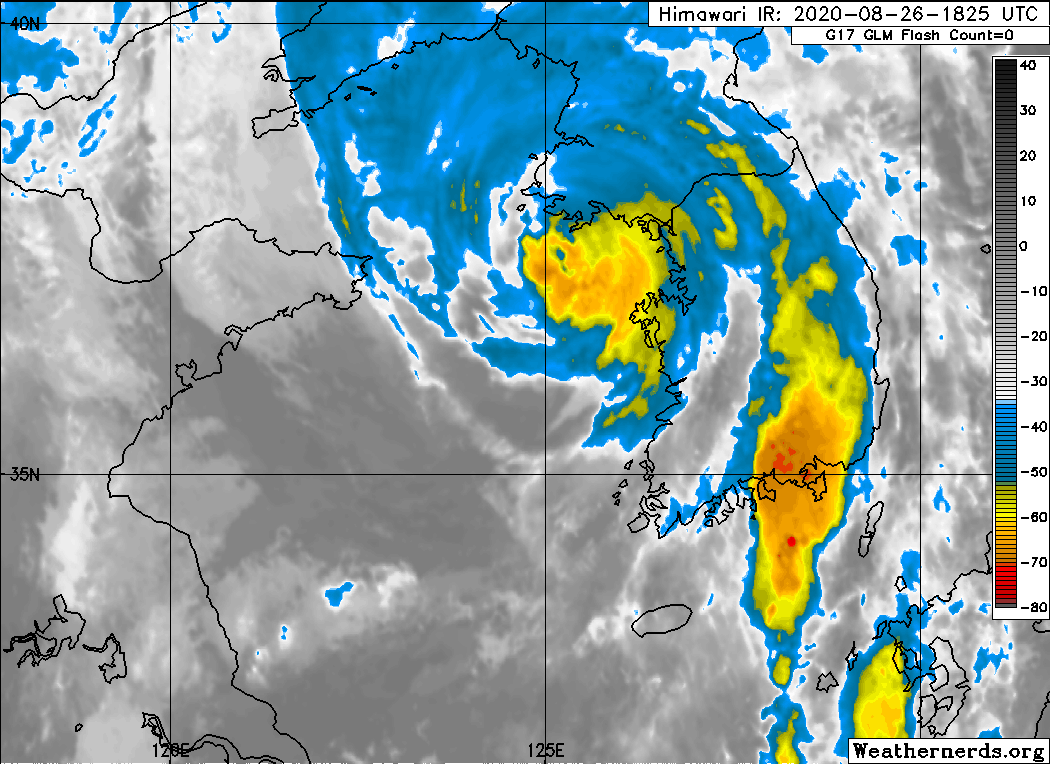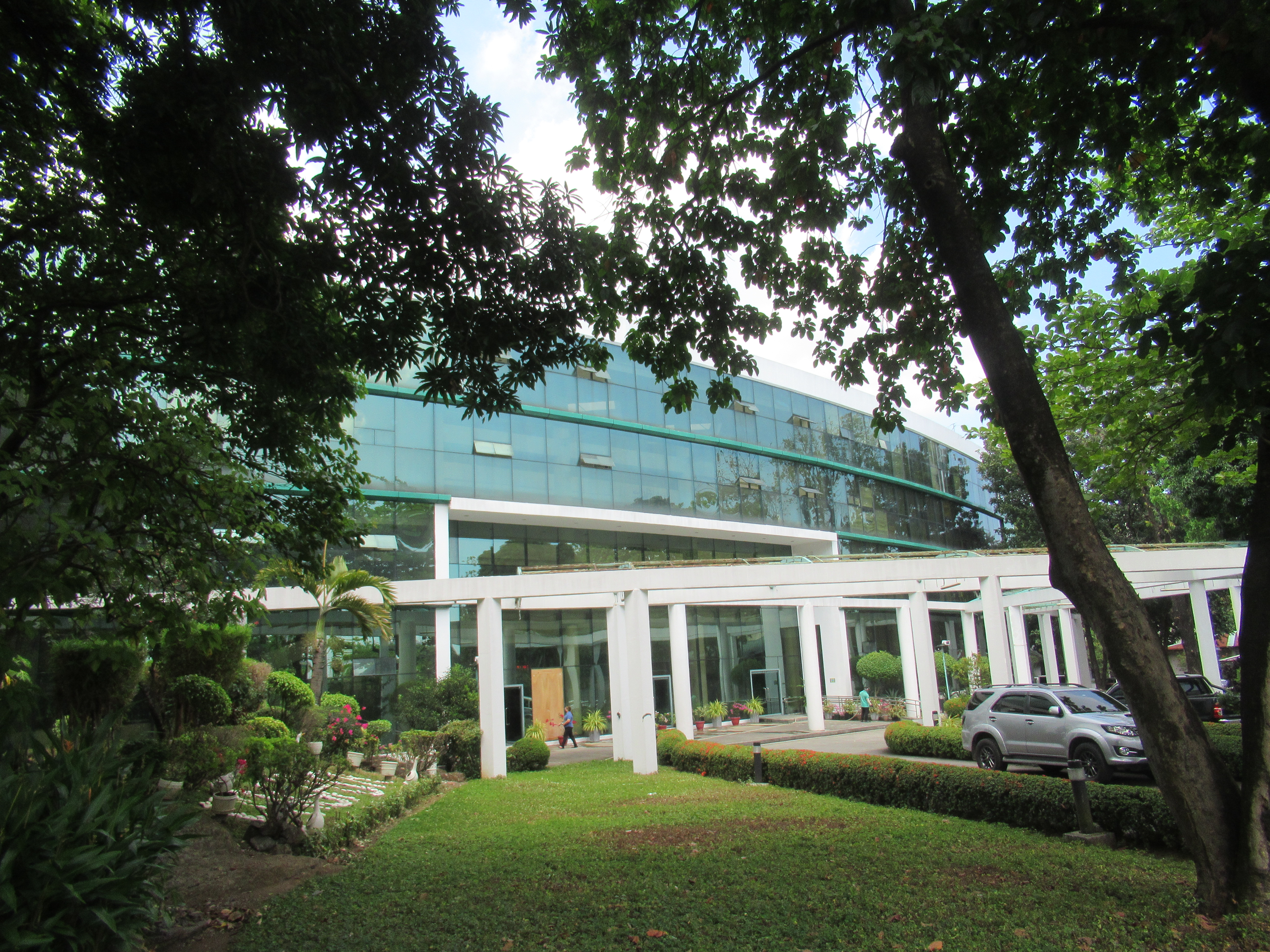|
Tropical Depression 06W (2020)
The 2020 Pacific typhoon season was the first of a series of four below average Pacific typhoon seasons, and became the first with below-average tropical cyclone activity since 2014, with 23 named storms, 10 of which became typhoons and only 2 became super typhoons. This low activity was a consequence of La Niña that persisted from the summer of the year. It had the sixth-latest start in the basin on record, slightly behind 1973, and was the first to start that late since 2016. The first half of the season was unusually inactive, with only four systems, two named storms and one typhoon at the end of July. Additionally, the JTWC recorded no tropical cyclone development in the month of July, the first such occurrence since reliable records began. Despite that, this season featured Super Typhoon Goni, which made the strongest landfall worldwide in terms of 1-minute wind speed. The season ran throughout 2020, though most tropical cyclones typically develop between May and November. ... [...More Info...] [...Related Items...] OR: [Wikipedia] [Google] [Baidu] |
Philippine Atmospheric, Geophysical And Astronomical Services Administration
The Philippine Atmospheric, Geophysical and Astronomical Services Administration (, abbreviated as PAGASA , which means "hope" as in the Tagalog word ''pag-asa'') is the National Meteorological and Hydrological Services (NMHS) agency of the Philippines mandated to provide protection against natural calamities and to ensure the safety, well-being and economic security of all the people, and for the promotion of national progress by undertaking scientific and technological services in meteorology, hydrology, climatology, astronomy and other geophysical sciences. Created on December 8, 1972, by reorganizing the Weather Bureau, PAGASA now serves as one of the Scientific and Technological Services Institutes of the Department of Science and Technology. History The ''Observatorio Meteorológico de Manila'' Formal meteorological and astronomical services in the Philippines began in 1865 with the establishment of the ''Observatorio Meteorológico de Manila'' (Manila Meteorologica ... [...More Info...] [...Related Items...] OR: [Wikipedia] [Google] [Baidu] |
Typhoon Maysak (2020)
Typhoon Maysak, known in the Philippines as Typhoon Julian, was a deadly, damaging and powerful tropical cyclone that struck the Ryukyu Islands and the Korean Peninsula in early September 2020. The third typhoon of the 2020 Pacific typhoon season, Maysak formed from a tropical disturbance. The disturbance gradually organized, receiving the name ''Julian'' from PAGASA as it became a tropical depression. As the depression strengthened, the JMA subsequently named the system ''Maysak''. Maysak rapidly intensified into a strong typhoon before weakening and making landfall in South Korea. Maysak was the second of three typhoons to affect the Korean Peninsula within two weeks, the others being Bavi and Haishen. It was also responsible for the loss of a livestock carrier Gulf Livestock 1, that sank 100 nautical miles West off from Amami Ōshima, Japan on September 2, 2020, taking 41 out of the 43 crew members on board. Meteorological history Following the impacts of Typhoon Bavi o ... [...More Info...] [...Related Items...] OR: [Wikipedia] [Google] [Baidu] |
Typhoon Bavi (2020)
Typhoon Bavi (transliterated from Vietnamese Ba Vì), known in the Philippines as Severe Tropical Storm Igme, was a powerful tropical cyclone that made landfall in North Korea in late August 2020. The eighth named storm and third typhoon of the 2020 Pacific typhoon season, Bavi formed from a low pressure area depression on August 21 to the north of the Philippines and strengthened into a tropical storm on August 22. Bavi gradually strengthened as it skirted Taiwan and Okinawa Prefecture, Okinawa, and became a typhoon on August 24. Passing over warm waters, Bavi turned to northwest and reached its peak intensity near Jeju Island on August 26. Thereafter, increasing wind shear and cooler waters caused Bavi to quickly weaken. Bavi made landfall in North Korea on August 27, and became an extratropical cyclone shortly thereafter. Bavi caused minimal damage in portions of South Korea and Japan, but caused widespread structural damage and flooding in North Korea. It was the first storm i ... [...More Info...] [...Related Items...] OR: [Wikipedia] [Google] [Baidu] |
Tropical Storm Higos (2020)
Severe Tropical Storm Higos, known in the Philippines as Tropical Depression Helen, was a tropical storm that affected China and Vietnam around the same area as Nuri two months prior. Higos formed from a tropical disturbance north of Luzon, the Philippines, on August 16. The storm tracked northeast and quickly intensified, becoming a tropical storm on August 17. The storm made landfall in Zhuhai, Guangdong at peak intensity on August 19, and quickly weakened soon after. Higos killed 7 people and caused 45 billion đồng (US$2 million) in damages in Vietnam. Higos also caused more than US$140 million in damages, but no fatalities in China. Meteorological history A new tropical depression formed from the Intertropical Convergence Zone east of Luzon on August 16. At 15:00 UTC, the PAGASA named the system ''Helen'' and began issuing severe weather bulletins for the tropical depression, but dropped the alerts as Helen left the Philippine area of responsibility after 4 hours. Around ... [...More Info...] [...Related Items...] OR: [Wikipedia] [Google] [Baidu] |
Tropical Storm Mekkhala (2020)
Severe Tropical Storm Mekkhala, known in the Philippines as Tropical Storm Ferdie, was a severe tropical storm that affected China in early August 2020 causing 1.1 billion yuan (US$159 million) in damage. However, no fatalities had been reported. Meteorological history An area of persistent convection formed within the proximity of a through that would spawn Tropical Storm Jangmi on August 7, west of Luzon. As Jangmi became the dominant system in the area, this low-pressure area remained disorganized. However, on the next day, as Jangmi moved away from the area, the system began to organize, and on August 9, the JTWC upgraded the storm to a Tropical Depression. Soon after, at 8:00 p.m. PST, the PAGASA followed and upgraded the storm and gave it the name Ferdie. By the next day, the JTWC upgraded Ferdie into a tropical storm. PAGASA then issued its last warning as Ferdie exited the Philippine Area of Responsibility. Then soon, the JMA followed suit and upgraded Ferdie to a tr ... [...More Info...] [...Related Items...] OR: [Wikipedia] [Google] [Baidu] |
Tropical Storm Sinlaku (2020)
Tropical Storm Sinlaku was a weak tropical cyclone that impacted Vietnam, Thailand and Laos in early August 2020. Beginning as a tropical depression on July 31 in the South China Sea, Sinlaku was the fifth storm of the 2020 Pacific typhoon season. It gradually organized as it took a slow west-northwest course, strengthening into a tropical storm the following day despite its monsoonal structure. The storm subsequently made landfall in Vietnam as a broad but weak tropical storm. Persistent land interaction weakened Sinlaku, leading to its dissipation on August 3. Sinlaku brought heavy monsoonal rains to much of Southeast Asia, especially to Vietnam, Laos, and Thailand. Two people were killed in Vietnam, and two people were killed in Thailand. Meteorological history In late July 2020, an area of atmospheric convection began to persist approximately 410 km (255 mi) east of Virac, Catanduanes. Afterwards, the Joint Typhoon Warning Center (JTWC) designated the system a lo ... [...More Info...] [...Related Items...] OR: [Wikipedia] [Google] [Baidu] |
Typhoon Hagupit (2020)
Typhoon Hagupit, (, ) known in the Philippines as Severe Tropical Storm Dindo, was a Category 1 typhoon that heavily impacted Eastern China and South Korea in early August 2020. It was the fourth named storm and the second typhoon of the annual typhoon season. The JMA began monitoring a tropical depression that developed in the Philippine Sea on July 30, with PAGASA assigning the name “Dindo” to the storm, later that day it strengthened into a tropical storm, according to the JMA. PAGASA issued its final advisory on Dindo early on August 3, as it moved out of their area of responsibility. Hagupit intensified into a typhoon on August 3, before making landfall in Wenzhou, China at 19:30 UTC that day at peak intensity. Hagupit subsequently weakened over China, before degenerating into an extratropical low on August 5. Hagupit's remnants persisted for another several days, as the storm moved eastward, before dissipating south of Alaska on August 14. Hagupit caused over a foot o ... [...More Info...] [...Related Items...] OR: [Wikipedia] [Google] [Baidu] |
Indian Ocean Dipole
The Indian Ocean Dipole (IOD), is an irregular oscillation of sea surface temperatures in which the western Indian Ocean becomes alternately warmer (positive phase) and then colder (negative phase) than the eastern part of the ocean. Phenomenon The IOD involves an aperiodic oscillation of sea-surface temperatures (SST), between "positive", "neutral" and "negative" phases. A positive phase sees greater-than-average sea-surface temperatures and greater precipitation in the western Indian Ocean region, with a corresponding cooling of waters in the eastern Indian Ocean—which tends to cause droughts in adjacent land areas of Indonesia and Australia. The negative phase of the IOD brings about the opposite conditions, with warmer water and greater precipitation in the eastern Indian Ocean, and cooler and drier conditions in the west. The IOD also affects the strength of monsoons over the Indian subcontinent. A significant positive IOD occurred in 1997–98, with another in 2006. T ... [...More Info...] [...Related Items...] OR: [Wikipedia] [Google] [Baidu] |
El Niño–Southern Oscillation
El Niño–Southern Oscillation (ENSO) is a global climate phenomenon that emerges from variation in winds and sea surface temperatures over the tropical Pacific Ocean. Those variations have an irregular pattern but do have some semblance of cycles. The occurrence of ENSO is not predictable. It affects the climate of much of the tropics and subtropics, and has links (Teleconnection, teleconnections) to higher-latitude regions of the world. The warming phase of the sea surface temperature is known as "El Niño" and the cooling phase as "La Niña". The Southern Oscillation is the accompanying atmospheric oscillation, which is coupled with the sea temperature change. El Niño is associated with higher than normal air sea level pressure over Indonesia, Australia and across the Indian Ocean to the Atlantic Ocean, Atlantic. La Niña has roughly the reverse pattern: high pressure over the central and eastern Pacific and lower pressure through much of the rest of the tropics and subtrop ... [...More Info...] [...Related Items...] OR: [Wikipedia] [Google] [Baidu] |
Central Weather Bureau
The Central Weather Administration (CWA; ) is the government meteorological research and forecasting institution of Taiwan (the Republic of China). In addition to meteorology, the Central Weather Administration also makes astronomical observations, reports on sea conditions, and conducts research into seismology and provides earthquake reports. The Central Weather Administration is headquartered in Taipei City and is administered under the Ministry of Transportation and Communications. History While Taiwan was under Japanese rule, the government set up five weather monitoring stations on the island, located in Taipei, Taichung, Tainan, Hengchun, and Penghu. On 19 December 1897, the Taipei Observatory moved to the location presently occupied by the Central Weather Administration. In 1945 when the Kuomintang took control of Taiwan the various stations set up by the Japanese were incorporated into the new Taiwan Provincial Weather Institution, under the Chief Executive of Taiwan Pr ... [...More Info...] [...Related Items...] OR: [Wikipedia] [Google] [Baidu] |
PAGASA
The Philippine Atmospheric, Geophysical and Astronomical Services Administration (, abbreviated as PAGASA , which means "hope" as in the Tagalog language, Tagalog word ''pag-asa'') is the National Meteorological and Hydrological Services (NMHS) agency of the Philippines mandated to provide protection against natural calamities and to ensure the safety, well-being and economic security of all the people, and for the promotion of national progress by undertaking scientific and technological services in meteorology, hydrology, climatology, astronomy and other geophysical sciences. Created on December 8, 1972, by reorganizing the Weather Bureau, PAGASA now serves as one of the Scientific and Technological Services Institutes of the Department of Science and Technology (Philippines), Department of Science and Technology. History The ''Observatorio Meteorológico de Manila'' Formal meteorological and astronomical services in the Philippines began in 1865 with the establishment of ... [...More Info...] [...Related Items...] OR: [Wikipedia] [Google] [Baidu] |


